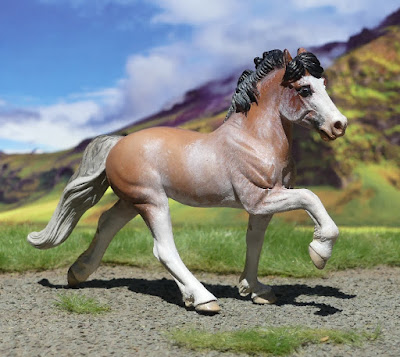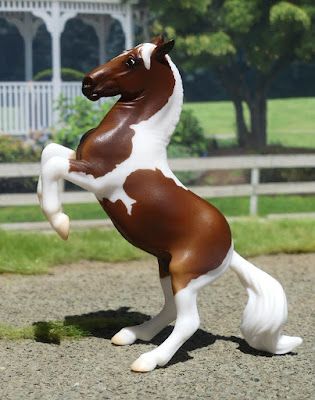Back when I reviewed Breyer's 2021 regular runs, one release which went straight onto my wishlist was the Palominos and Pintos Stablemates set, and they did in fact end up being the first of this year's models I ordered.
Here's all the horses together - often the sets seem to include some horses I really admire, and others I'm not mad about, and occasionally one terrible paintjob I actively dislike, but this contains four good mould & colour combinations and all of them nicely done.
Let's have a closer look at them individually...
The chunky trotting warmblood, or 'driving' mould, in sooty palomino pinto. The patch markings are really neatly outlined, it's a shame the mane masking wasn't so carefully done, with quite a lot of the body colour overlapping the ends of the hair. It's the sort of thing to look out for if you get chance to pick your set in person, rather than shopping online - just be aware that's an area with varied quality control, and have a quick check of several boxes to pick the nicest one!

Darley in golden palomino - the metallic aspect of his paintjob isn't over-done, just enough that he looks like the palominos who carry a gold sheen on their summer coats, and the best thing is, it's only in the palomino colour paint, they didn't use a pearly base-coat to include his mane, tail, socks, and hooves in the metallic finish, as inflicted on some other unfortunate models!
This one looks like he has a strange mane masking glitch - below the obvious chunk of hair there appears to be a phantom outline of some extra mane, but if you look closely, there is a 3D layer of thin hair flat against the shoulder in the sculpt!
There he is from the other side, do you see what I mean about looking more like an American gaited cross than a pure old world arabian? Our arabs in Europe, both Britain and the continental mainland, tend to be short-coupled and deep and rounded, with an action more floaty than high and flashy. Darley may be a prime example of an arabian for the US show ring, and American Breyer fans might love it for that, but as a British horse fan and collector, I just can't take this mould as the arabian strains I'm familiar with, so I show all mine as National Show Horses (arab x saddlebred), and think them a very nice model of this breed instead!
In all the years I've been collecting Breyer Stablemates, I've never seen them do a really pale palomino before! This quarter horse mare is described as an Isabella palomino on the box, and her colour is very delicately done, with areas sprayed lightly or heavily to vary the shading, and a grey nose to make sure the creamy tone with white mane and tail doesn't misread as cremello.
One of my favourites done on this mould, there's a certain something about it when the paintwork suits the model and just works.
The last of the four, while at a glance he might look like a chestnut, he's actually described as a chocolate palomino, which I always thought was just a term for a really dark sooty palomino, but I've read recently that it's the result of a liver chestnut base plus a cream gene. Maybe a liver chestnut with sooty AND cream gets you this shade!


Whatever his fictional plastic genetics, he's a really adorable little model, the Darwin mould sculpted as a lipizzaner but suiting a wide range of colours. Pinto was found in the historical ancestors of today's modern lipizzaner breed, as seen in glorious 17th and 18th century oil paintings and engravings, so there's the option to show him as a historic model, or you could go with a partbred, or pick something else entirely. I'm currently constructing a 'Historical' page on my website for all the obsolete colours and customs painted from old artworks, so he'll find his home there shortly.
Another 2021 addition to the Stablemates range was a Horse Foal Surprise - not just strange grammar which I can't quite make a sensible sentence from in my mind, but a strange combination of re-release and brand new model. In each box you got the same adult and foal as last year's Stable Surprise set, plus one new adult to complete the family. But the new horses aren't available seperately, so you have three options : buy the set and end up with duplicates in you bought last year's batch; miss out on the new ones; or hope that someone might split sets and sell the models singly. Luckily, Chestnut Ridge do exactly that, selling out-of-box/bag models individually, so you can pick exactly which you like and leave those you don't need.
Of course, I picked out the three new horses for my herd.
The good old G3 mustang mould in a simple but effective chestnut, I like his snip and the fade out of his tail to flaxen. This one was paired with the dark bay tobiano paint horse mare from last year.
These paintjobs are nice enough that they'd sell as singles, but probably not exciting enough to go ahead and buy the whole set of three if you only lack the new horse from each family.
This quarter horse mare was paired with the...wait a minute, I think I've spotted a mistake, Breyer.
The dun warmblood mare. And these two females have somehow produced a foal.
I wonder if this is linked to the fact the warmblood was initially named as the Warmblood Stallion mould on IdentifyYourBreyer - maybe a collector tip-off corrected that site's mistake, but Breyer themselves were still under the impression it's a stallion when compiling this family group? Oops!
Anyway, I do like this mare a lot, her faintly shaded black looks sleek and striking, and I just love the big chunky white snip on her nose, that design choice gives her so much character and was why I wanted her so much, I'm glad to be able to buy these singly.
The G3 warmblood in a nice mahogany bay, paired with the palomino walking TB, makes up the third and final set. For some reason, 2020's roan Icelandic wasn't re-used, and it can't be cos they only have one mould of that breed, as they rarely match breeds together in the mystery foal type sets anyway - last time the Icelandic was crossed with an Appaloosa!
And to finish on, a couple more of the 70th Anniversary Stablemates blind bags, each mould a mini version of a Traditional scale sculpt. These aren't 2021 releases but having taken a year to reach the UK stockists, they may as well be!
The missouri fox trotter, not a mould I like enough to have ever bought a Trad size one, but the mini is a very sweet little horse indeed, and I can see myself ending up with several of these if they release them in more colours down the years.
I think I got a fairly dark variation here, a lot of the fox trotters have been a paler shade of grey with a lot less shading on the mane, but I really like this one's darker look, even if he was a bit of heavy-handed spraying compared to others!
And mini Emma, also known as the Fell Pony mould, though fells never come in chestnut so she'll have to be allocated something else in my collection!
She's an adorable little chunky pony, not far off the G3 Highland for size, she's so neat and small and light she feels like a half-size Stablemate in hand! It's unusual to see such a cobby type as a smaller model, but she makes a great addition to the range, I'd like to see them release her in black like the original large scale Fell Pony, but also in piebald and skewbald as the 'pony cobs' which are rapidly gaining popularity in the UK.
This mean there's only one 70th Anniversary model left for me to collect, excluding the chase pieces (I'm not into decorators to seek those out, though I'd keep them as colourful oddities if I happened on them by chance, like the copper filigree Django I got from the first series of blind bags). And I haven't painted any of these new mini moulds yet, so I'm not ruling out ordering another batch pot-luck or pick'n'mix at some point : Stablemates are addictive!










































